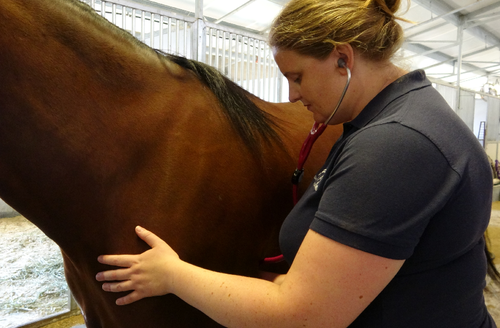
Despite their athleticism, roughly 50 percent of healthy racing thoroughbreds experience cardiac arrhythmias — or, irregular heartbeats — when exercising. Nineteen percent of horse deaths on the racetrack are considered sudden, but only 53 percent of those sudden death cases receive a diagnosis. Racehorses are specifically bred for athletic performance, and yet, nearly half of them are still experiencing arrhythmias.
Sian Durward-Akhurst, an assistant professor of genetics, genomics, and large animal internal medicine in The College of Veterinary Medicine, shares expert analysis on identifying causes of these deaths and understanding which racehorses are at risk of arrhythmias and sudden cardiac death.
Sian Durward-Akhurst, BVMS, MS, PhD
“Irregular heart rhythms, or cardiac arrhythmias are thought to be an important cause of sudden death in racehorses. Reducing the number of racehorses that die each year is a major goal of the horse racing community. Unfortunately, it is currently not possible to identify which horses are at high risk of dying during racing.
“Our research group is focused on developing tools that would enable us to identify horses at high risk of sudden death due to arrhythmias (sudden cardiac death) before they develop an arrhythmia. We are doing this by using computational analysis of electrocardiograms in resting horses and establishing the role that genetics play in the development of potentially fatal arrhythmias.
“Our goal is to develop screening diagnostic tools to identify horses at high risk of sudden cardiac death. This would allow us to monitor these horses more closely and only allow them to race when they are safe to do so. Additionally, once we identify the genetic cause of these arrhythmias, we will be able to develop a genetic test that allows breeders to make educated breeding decisions to reduce the frequency of arrhythmias and sudden cardiac death in racehorses.”
Sian Durward-Akhurst is an assistant professor of genetics, genomics, and large animal internal medicine. Her primary interests include cardiovascular disorders, in particular cardiac arrhythmias that contribute to sudden cardiac death. Her research focuses on understanding the genetic and electrophysiologic mechanisms of these arrhythmias in horses. She also investigates other detrimental diseases in horses that are similar to simple inherited diseases in humans. You can learn more about her research here.
Contact information:
University Relations | Rachel Cain
[email protected]
About the College of Veterinary Medicine
The University of Minnesota College of Veterinary Medicine affects the lives of animals and people every day through educational, research, service, and outreach programs. Established in 1947, the University of Minnesota College of Veterinary Medicine is Minnesota’s only veterinary college. Fully accredited, the college has graduated nearly 4,000 veterinarians and hundreds of scientists. The college is also home to the Veterinary Medical Center, the Veterinary Diagnostic Laboratory, the Leatherdale Equine Center and The Raptor Center. To learn more, visit vetmed.umn.edu.
-30-
- Categories:
- Health
- Animals
- Health conditions




